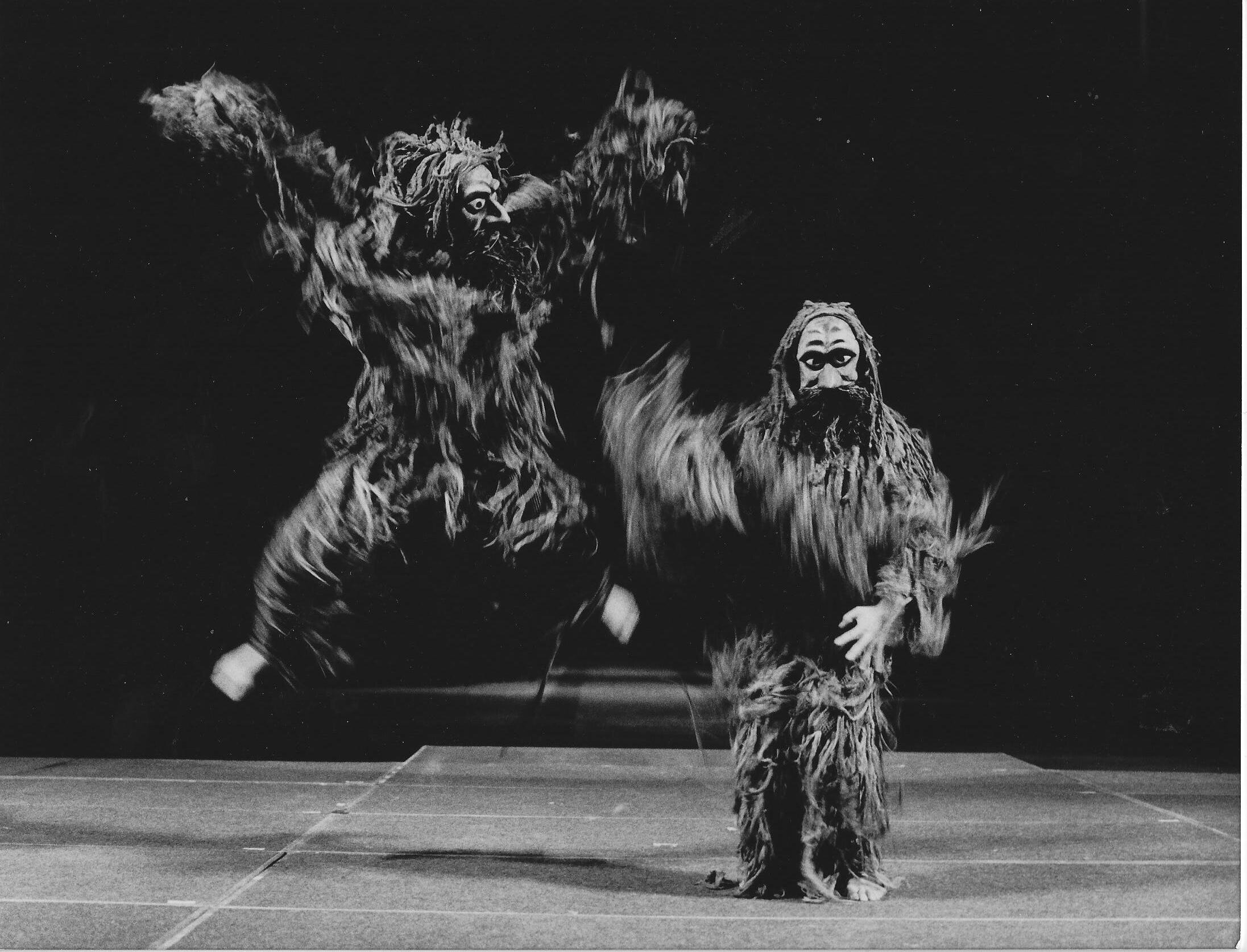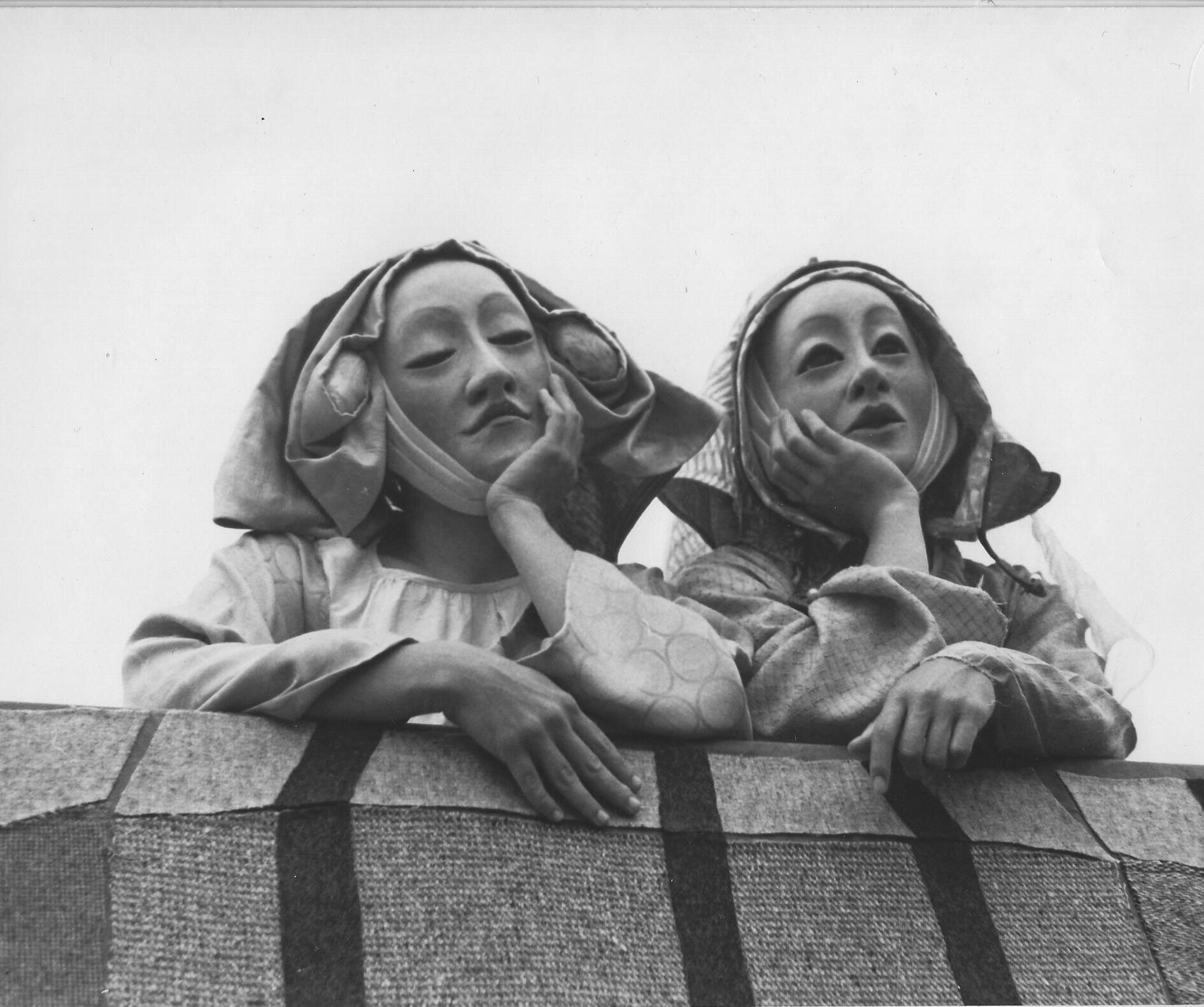Theatre of Transcendence: The Wildman
Ralph Lee’s The Wildman, which was performed at the Cathedral of St. John the Divine in New York City was perhaps the first transcendent experience that I had in the theatre. It changed the way that I looked at what was possible on stage.
I have since spent more than 30 years using theatre to explore myth. Or perhaps using myth to explore theatre. Either way, I believe that my experience seeing The Wildman was the flame that ignited my obsession with myth.
Ralph Lee (and friends)
Ralph is a multi-award-winning theatre artist who creates puppets, masks and writes and directs his own work. He founded the Greenwich Village Halloween parade in 1974, which is now one of New York’s main events. (And after the Pandemic, it will come back!) He has been an Artist in Residence at the Cathedral of St. John the Divine in New York City for decades. And he is the Artistic Director of The Mettawee River Theater company, which creates theatre based on creation myths, trickster tales, Sufi stories, legends, and world folklore.
I’ve known Ralph for over thirty years and, although I have not worked with him directly, I consider him one of my mentors.
The Wild Man in one of his depictions, this one from Germany
The Wildman has no plot and is a series of ten short vignettes, chiefly dramatizing the medieval character of the wildman in his many personae. You can see the wildman portrayed in European artwork beginning in the 12th century.
The Green Man (not The Wildman)
The Wildman is not to be confused with The Green Man, another medieval icon of nature, whose face is all over the place in the cathedrals of Europe.
Also not The Wildman…
He is also not to be confused with Gargoyles, Moss People, Bugbear, the Apple Tree Man, the Mothman, or Bigfoot. Boy, there is a lot to unpack here.
The performance took place in the nave of the Cathedral, which, if full, would fit 900 people. However, the audience did not sit in the pews and face the chancel (where the clergy perform the mass). They sat in the chancel and faced the grand empty Cathedral interior.
It was the only indoor performance I’ve seen to make use of such a huge space. The “playing area” was over 30,000 square feet and the ceiling was 40 yards high. Normally, the playing space of a theatre will occupy just a fraction of the space that the audience occupies. Here, the playing space was maybe 50 times the size of the space occupied by the audience. That alone was extraordinary.
Cathedral of St. John the Divine
I was raised a Catholic, so the interior of a cathedral is already crammed with meaning for me (even though St. John is an Episcopal Cathedral). Grotowski talked about the actors and audience sharing some common ground, a collective unconscious – myths that are not “an invention of the mind,” but “are inherited through one’s blood, religion, culture, or climate.” The cathedral is such a milieu for me. Even so, I believe that one could not help but be overwhelmed by seeing a performance in such an enormous space. It is the largest cathedral in the world.
There was live orchestral accompaniment to the piece, provided by instruments on the side. There is nothing that compares to the sound of acoustic instruments in such a vast expanse.
Most of the vignettes were introduced by the actors using short poems. But these poems were indeed poetical and did not seek to explain what we were about to see. Without them, the piece would still work its magic.
Two Wlidmen. copyright 1987 Photo by Mary Bloom
The actors were either in full face masks or visibly worked life-sized puppets in the style of bunraku.
The play started with figures in gowns, ever so far away from us, slipping in and out of the light.
This soundless opening was ephemeral and brought about the esoteric ritual in which we took part. This performance was not about letting us in and explaining everything. It metaphorically drew back a curtain and allowed us to step into a world that was centuries old. Every manifestation of The Wildman was a different actor, and a different costume, and different mask. Or at least that’s how it seemed to me. We are first introduced to The Wildman as a friendly stranger in the first vignette. But in the second vignette he is a thing to be feared. He was also portrayed as a character of sexually exuberance and as a comic, childlike simpleton. All of these scenes were without language and of course no language was needed.
The “mad” Wildman / copyright 1987 Photo by Mary Bloom
One of the most powerful scenes portrayed The Wildman as figure driven mad by loneliness and unable to account for his place in the world. The Mad Wildman ran in and out of the darkness, chased by invisible terrors, body wracked by uncontrollable contortions and trying unsuccessfully to make the world around him bend to his will. It was a sad, gut-wrenching scene. It is a testament to Ralph’s genius that he was able to create this painful, existential playlet for a character that we only met for less than ten minutes, and with no backstory.
Mary Magdalene, (in one of the outdoor performances) operated by David Amarel, Elliot Scott, Tom Marion & Bruce Barton, copyright 1987 Photo by Ralph Lee
The highlight of the play for me was the scene which a life-sized puppet of Mary Magdalene was brought in on a barge and animated by actors in plain view. I have no idea what the character of Mary Magdalene has to do with The Wildman. But in the context of this piece it made perfect sense, and I can’t explain why. This scene with Mary was like a beautiful slow aria in the middle of a concerto of percussion. The puppet was gorgeous, and her movements - beautifully orchestrated by the actor/puppeteers - were lyrical. It was a rapturous scene.
Mythical Beasts, copyright 1987 Photo by Mary Bloom
The piece ended with a dance of strange beasts and the arrival of a 20-foot-tall wicker Wildman which was wheeled in from the very back of the Cathedral barreling toward us at great speed and, as it seemed, onto our very laps. This ending was a crescendo of scale, spectacle and theatre which brought the event to a thrilling and unexpected culmination.
I have said in a previous blog that I have an affinity for plays that go back in time. In this case, it was we the audience who were transported back in time. Ralph’s particular alchemy of darkness, space, mask, esoteric subject matter and lack of language created a vast well through which we fell, finding ourselves eight centuries in the past. For an hour we witnessed things which could not be explained away - not through reason, not through science, and not through religion. I feel lucky to have been a part of that journey.
The Wildman: Two Maidens, copyright 1987 photo by Ralph Lee
The Wildman
From stories and images of medieval and renaissance Europe
Poems by Dave Hunsaker
Lyrics by Martin Edmunds
Directed and Designed by Ralph Lee
Costumes by Casey Compton
Music Composed by Paul Halley
Music Arranged and Performed by Jody Kruskal
Choreographed by Don Redlich
Production Manager: Bruce Fifer
Performers: David Amarel, Lenny Bart, Bruce Barton, Pamela Dharamsey, Martha Gilpin, Tom Marion, Deb Piver, Elliot Scott










